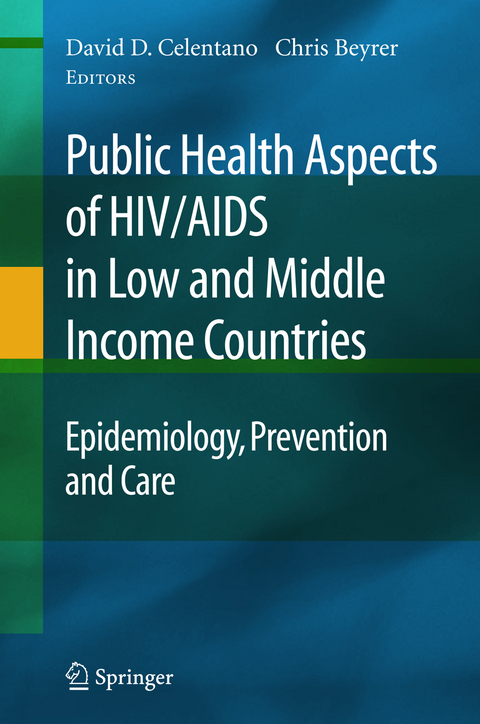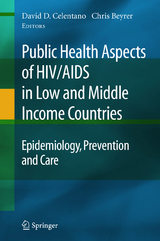Public Health Aspects of HIV/AIDS in Low and Middle Income Countries
Springer-Verlag New York Inc.
978-0-387-72710-3 (ISBN)
It has now been 25 years since the apocryphal report in the CDC Morbidity and Mortality Weekly Report dated June 5, 1981 entitled, “Pneumocystis Pneumonia - Los Angeles”, which announced what was to become HIV/AIDS. HIV has now affected virtually all countries that have looked for it and has had a devastating impact on the public health and medical care infrastructure around the world. HIV/AIDS has also disproportionately affected nations with the least capacity to confront it, especially the developing world nations in Sub-Saharan Africa, South and Southeast Asia, and the emerging republics of Eastern and Central Asia. The pandemic, unlike any other disease of our time, has had profound impacts on the practice of public health itself: bringing affected communities into decision making; demanding North-South partnerships and collaborations; and changing the basic conduct of clinical and prevention trials research. While much has been written in scholarly publications for medical, epidemiologic and disease control specialists, there is no comprehensive review of the public health impact and response to HIV/AIDS in the developing world.
This edited volume seeks to systematically describe the emergence and form of the epidemics (epidemiology), the social, community and political response, and the various measures to confront and control the epidemic, with varying levels of success. Of particular importance are strategies that appear to have been useful in ameliorating the epidemic, while contrasting the situation in a neighboring country or region where contrasting prevention or care initiatives have had a deleterious outcome. Common to all responses has been the international multi-sectoral response represented by the Global Fund for HIV/AIDS, Malaria and Tuberculosis, the President's Emergency Plan for AIDS Relief, and the Gates Foundation, among others, to promote HIV pharmacologic therapy in resource-poor settings. The chapter authors will explorethe political challenges in meeting HIV/AIDS prevention and care in concert with the public health realities in specific country and regional context.
David D. Celentano is a Professor in the Department of Epidemiology and Director of the Infectious Diseases Epidemiology Program at the Johns Hopkins Bloomberg School of Public Health. His research integrates behavioral science theory and research with epidemiology, in the study of behavioral and social epidemiology. Celentano is the Principal Investigator of four NIH-supported studies in Thailand, focusing on interventions to influence the association between opiate use, methamphetamine use, and other drugs on HIV. Chris Beyrer is Associate Professor in the Department of Epidemiology at the Johns Hopkins Bloomberg School of Public Health. He is also the Founder and Director of the Center for Public Health and Human Rights at Johns Hopkins. He is a co-editor of Public Health and Human Rights: Evidence-Based Approaches, to be published in 2006 by Johns Hopkins University Press.
Epidemiology of HIV/AIDS in Low and Middle Income Countries: Where Global AIDS is and Where it is Going.- HIV Prevention Needs: Primary Prevention and Prevention for People Living with HIV/AIDS.- Future of HIV/AIDS Care in Low- and Middle- Income Countries.- HIV/AIDS Care: The Minimum Package and Scaling Up.- HIV/AIDS Vaccine Research.- Microbicide Development.- How the Pandemic Shapes the Public Health Response – the Case of HIV/AIDS in Brazil.- Advocacy, Activism, Community and the AIDS Response in Africa.- Political Challenges to Mounting and Sustaining a Public Health Response to HIV/AIDS in Developing Countries.- Sub-Saharan Africa.- The HIV/AIDS Epidemics of Africa.- The Situation in the Cradle of AIDS: Congo and Central Africa.- Public Health Aspects of HIV/AIDS – Nigeria and West Africa.- East Africa – Kenya, Tanzania & Uganda.- Southern Africa (South Africa, Botswana, Lesotho, Malawi, Mozambique, Namibia, Swaziland, Zambia, Zimbabwe).- HIV/AIDS in the Horn of Africa.- South and Southeast Asia.- HIV/AIDS in South and Southeast Asia: An Overview.- China.- The HIV/AIDS Epidemic in Thailand – The First Two Decades.- HIV AIDS in Burma: Public Health Constrained.- The HIV Epidemic in Vietnam: Past, Present, and Opportunities.- Malaysia.- Towards Equitable and Quality HIV Prevention and Care Services: Assessing the Situation in India.- Eastern Europe & Central Asia.- The HIV/AIDS Epidemics in the Former Soviet Union, Central Asia, and Iran.- Russian Federation.- HIV in Central Asia: Tajikistan, Uzbekistan and Kyrgyzstan.- Drug Abuse and HIV Transmission in Iran—Responding to the Public Health Challenges.- Latin American and Caribbean.- The HIV/AIDS Epidemics of the Americas.- Epidemiology, Prevention and Care of HIV in Peru.- AIDS in Brazil: The Challengeand the Response.- The State of HIV/AIDS in the Dominican Republic: Guarded Optimism amidst Sustainability Concerns.- Public Health Aspects of HIV/AIDS in Haiti: Epidemiology, Prevention and Care.- HIV/AIDS Prevention, Treatment and Care: Present Status, Future Needs and Some Possible Solutions.
| Zusatzinfo | XXII, 754 p. |
|---|---|
| Verlagsort | New York, NY |
| Sprache | englisch |
| Maße | 178 x 254 mm |
| Themenwelt | Studium ► Querschnittsbereiche ► Epidemiologie / Med. Biometrie |
| Studium ► Querschnittsbereiche ► Infektiologie / Immunologie | |
| Studium ► Querschnittsbereiche ► Prävention / Gesundheitsförderung | |
| ISBN-10 | 0-387-72710-8 / 0387727108 |
| ISBN-13 | 978-0-387-72710-3 / 9780387727103 |
| Zustand | Neuware |
| Haben Sie eine Frage zum Produkt? |
aus dem Bereich




